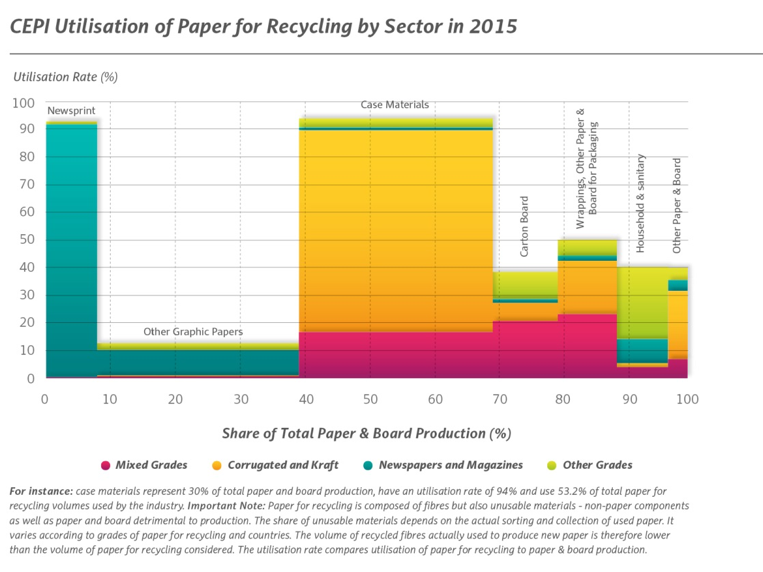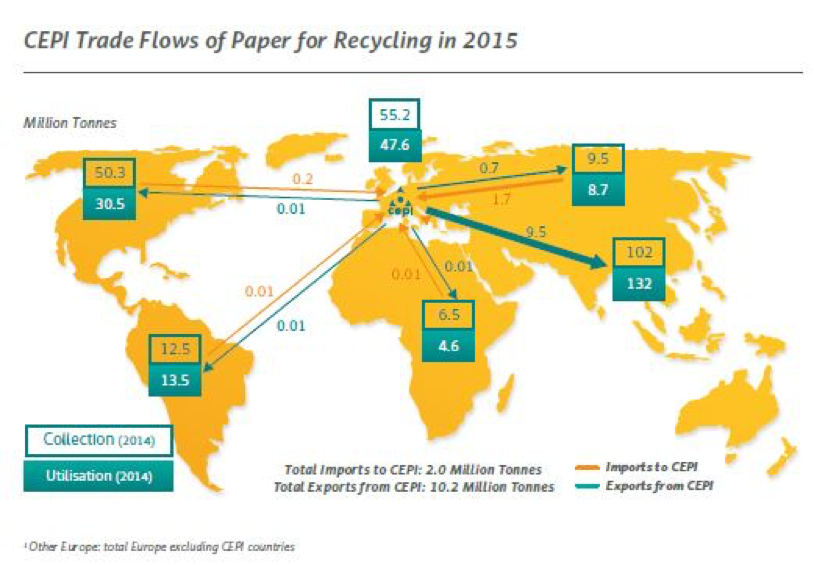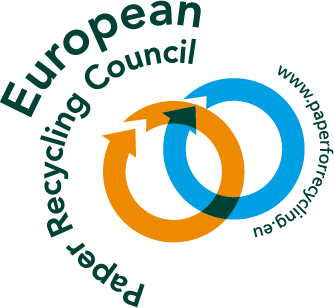General
Why recycle paper?
Because it makes sense from an economic and ecologic standpoint. Paper recycling is perceived by the public as being the most effective way to reduce environmental impacts of using paper. For the industry, recycled fibres are an indispensable source of raw materials, supporting industry’s resource efficiency.
How does Europe compare to the rest of the world?
The CEPI recycling rate is well above the North American rate and world average levels. While Asia’s utilisation rate is higher than that in the CEPI area, this is only possible because Asian countries import great volumes of paper for recycling from North America and Europe, where collection and waste management are highly developed.
Who collects paper for recycling?
Legally, the municipalities have the responsibility to organise the collection of waste and therefore are often the owners of the waste. The paper industry, to achieve its recycling goals, cooperates with municipalities, paper for recycling collectors, waste managers, publishers and packaging manufacturers. The Waste Directive obliges member states to set up separate collection of inter alia.
Where is paper collected from?
More than 60 million tonnes of used paper are collected in Europe. The main sources of paper collection are 50% from trade and industry, 40% from households, and 10% from offices.
Why is the paper industry favouring separate collection?
For many years, the paper industry has done a lot of work to improve the quality of used paper collection. Separate collection increases the quality of Paper for Recycling, therefore all actors, even households, must recognise that they are handling a secondary raw material and not waste, and accept the responsibilities this implies. Some countries collect old newspapers and magazines from households separately from paper and board packaging. Sometimes all papers are collected together. What is decisive is that paper and board for recycling is collected separately from other materials and in particular separately from household waste.
What can be recycled?
Almost any paper can be recycled, including used newspapers, cardboard, packaging, stationery, direct mail, magazines, catalogues, greeting cards and wrapping paper. It is important that these papers are kept separate from other household waste, as contaminated papers are not acceptable for recycling. There are, however, paper products that cannot be either collected or recycled. The share of such paper products, which consist, for example, of cigarette papers, wall papers, tissue papers and archives, is estimated to be about 19% of the total paper consumption.
Are there limits to the recycling of paper?
A fibre can be recycled several times, yet not indefinitely, depending on the paper grade. Therefore, there is a continuous need to feed the inflow of recovered fibre with paper products made of virgin pulp. Paper recycling needs to continuously incorporate a certain amount of fresh fibres for three main reasons:
- Strength:
- Cellulose fibre deteriorates each time it is recycled.
- Depending upon the type of paper being made, it can be reused several times.
- Quality:
- While most, if not all, paper and board types could be made of 100% paper for recycling, some products need top quality paper for recycling, (like cuttings and shavings from printers), which is not widely available.
- Some paper and board type production makes little or no use of paper for recycling. This can be partly due to the quality requirements of the end-product, such as high-grade artwork, or the technical characteristics needed for many special purpose types, such as security paper, which prevents fraudulent use of documents.
- Availability:
- Around 19% of the paper we use is not possible to collect or recycle.
- Some paper products are not sent for recycling – for example, books, documents and photographs kept at home or in archives and libraries.
- In other cases, paper products deteriorated or are destroyed when used – such as sanitary paper or cigarette paper.
Who uses paper for recycling?
The paper industry is the largest recycler in Europe. Paper for recycling is particularly suited for applications such as newsprint and packaging. However, for some “higher quality” publication paper and some packaging applications, for example, only top quality paper for recycling can be used but it is not available in large quantities. The average utilisation rate is 52.5%. Newsprint is a big user of paper for recycling. Its utilisation rate of paper for recycling has reached 92.3% (2015).
Other main users of paper for recycling:
- Packaging: 74.4% of the total volumes
- Household and sanitary papers, 40%, a lower level than in recent years. The main explanation for this is the consumers’ increasing choice for soft hygiene products. Softness is more efficiently reached through utilisation of virgin fibres.
- The fresh fibres in magazines and other high grades are needed for renewing the paper for recycling wealth.

Why is quality important?
Quality and quantity are to a certain degree linked, as it is a challenge to maintain the quality of paper for recycling while quantities are increasing. The increased collection of paper in total, and especially the increasing share of paper for recycling coming from households, would, if not addressed adequately, result in a higher level of impurities. The paper industry is therefore continuously improving practices to maintain the quality of paper for recycling whereas the collection rate is increasing.
The Confederation of European Paper Industries (CEPI) together with other European associations from the paper chain have launched a set of quality guidelines for paper for recycling. These guidelines for responsible sourcing and supply of paper for recycling define the requirements that have to be taken into account in each step of the chain (collection, sorting, transportation, storage, use). Responsible sourcing has an impact on the overall sustainability of the industry: It improves working conditions and the availability of recovered fibres and it significantly contributes to environmental performance by reducing the amount of rejects and decreasing unnecessary transportation of (non-recyclable) material.
Does the EU have any legislation on paper for recycling?
Yes, the EU Waste Directive (2008/98/EC) which is currently under revision within the Circular Economy package.
Can paper for recycling be traced?
The Confederation of European Paper Industries (CEPI), the European Federation of Waste Management and Environmental Services (FEAD) and the European Recovered Paper Association (ERPA) have set up the Recovered Paper Identification System to identify the origin of the paper for recycling purchased, received, stored and consumed by the paper mills.
This European Recovered Paper Identification System starts at suppliers’ sources and depots and ends at the conveyor to the pulper: every member in the paper for recycling chain has to keep track of his/her supplier. More information can be found at www.recoveredpaper-id.eu
The Recovered Paper Identification System is complementary to any legal requirements and to the delivery document.
Is there a European standard for paper and board for recycling?
Yes, the European List of Standard Grades of Paper and Board for Recycling can be found in a European Standard EN 643. It divides paper for recycling into five groups: ordinary grades, medium grades, high grades, kraft grades and special grades. Each of these groups has some subgroups which specify the recovered paper grade at a detailed level. The EN 643 also defines and sets tolerance levels such as unusable materials, non-paper components, paper and board detrimental to production and moisture content. You can find out more at https://www.cepi.org/en643.
Is recycled paper appropriate for food contact?
It is indeed. The paper industry has developed standards and good manufacturing practice for materials intended for food contact applications, and has to meet requirements set by a European Framework Regulation 1935/2004 and relevant national legislation. However certain collected paper streams are inappropriate as secondary raw materials for the production of paper and board intended to come into contact with foodstuffs. These paper streams are originally defined by the Council of Europe. Examples for inappropriate paper streams are paper and board collected mixed with garbage, used hygienic paper, contaminated paper from hospitals and old archives, if they contain PCBs.
Does the industry export paper for recycling?
Paper for recycling is a commodity on international markets just like any other product and is increasingly traded. Western Europe and North America have well developed collection systems whereas Asia, and particularly China, depends on imports of paper for recycling.

Are there any other recovery options for paper for recycling?
Re-use:
Other recovery options include re-use, organic recycling and incineration. Re-use in particular has been given strong support in some countries (e.g. the German deposit on beverage cans). Promotion of re-use ignores all the other environmental aspects, for example the renewability and safety as well as the impact of return transportation and washing of re-used material, however paper and board products are also commonly re-used, without needing to be washed or otherwise prepared – another benefit of paper!
Biomass incineration:
Due to its renewable origin, paper for recycling is considered as biomass and therefore a renewable energy resource. It is true that incineration of used paper generates renewable energy and therefore allows the substitution of fossil fuels but it is more efficient to burn used fibres only when they can no longer be recycled. The paper industry therefore asks that no subsidies for incineration should be introduced where material recycling is sustainable. Additionally, the Waste Directive gives recycling a clear priority over incineration.
Composting:
Dueto its biological origin, used paper is biodegradable and compostable. The Waste Directive includes composting in material recycling, however, the difference is that once paper is composted it disappears from the paper recycling loop. For materials that are not suitable for recycling, for example paper soiled with food, composting would be a good alternative to incineration or landfilling, and used paper bags are a good carrier for bio-waste. At the moment, any paper going for composting is not included in the calculation for the European recycling rate.
What can help increase the recycling level?
- Separate collection of used paper.
- Increasing use of paper for pecycling in paper manufacturing.
- General opinion favours an increase in used paper collection and recycling.
- Paper for recycling exports to countries outside Europe are expected to increase.
- Collection activity and volumes in new EU countries, Bulgaria and Romania are expected to grow fast from a current low level.
- Active industry role to increase collection activity (educational campaigns, developing collection and sorting practices, technical research, quality management, etc)
- Wider participation of the paper recycling chain in the European Declaration on Paper Recycling.

